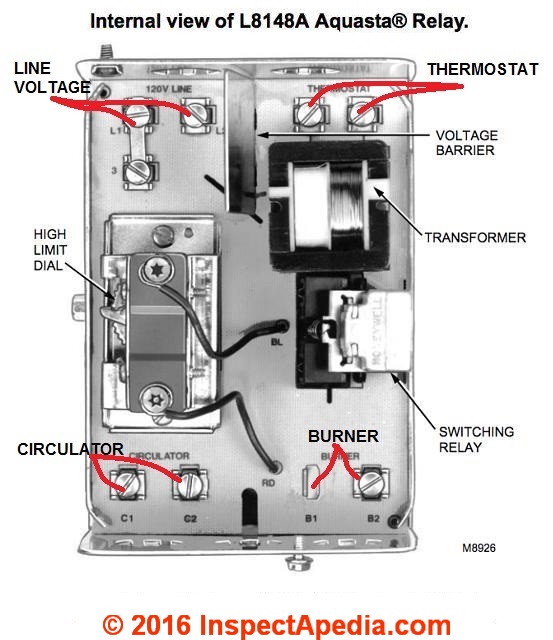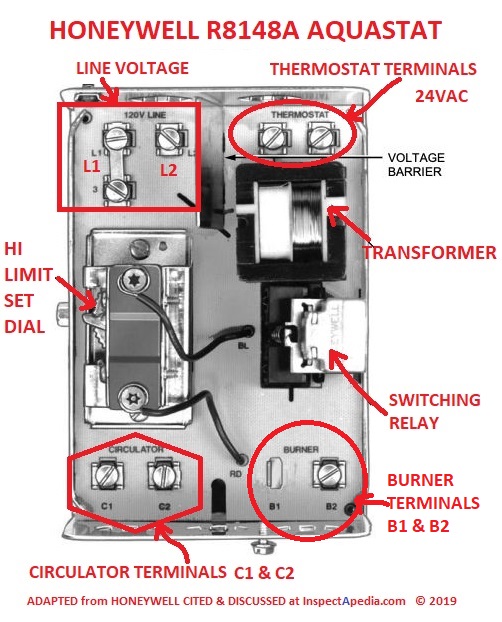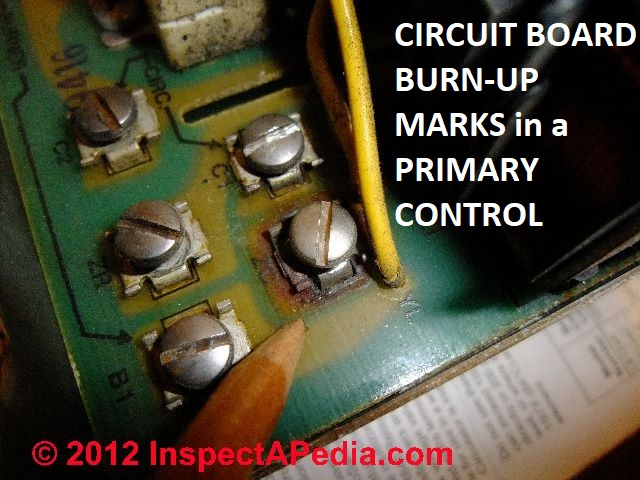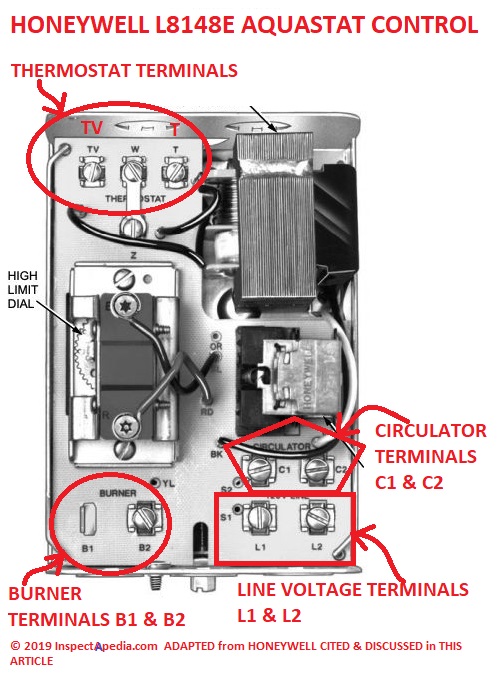 Honeywell / Resideo L8148 Aquastat Controller Repair
Honeywell / Resideo L8148 Aquastat Controller Repair
Troubleshoot L8148 aquastats
- POST a QUESTION or COMMENT about L8148 Series Aquastats controls used on Heating Boilers
Guide to troubleshooting & repairing the Honeywell (now Resideo) L8148-series aquastat controls on heating equipment:
This article series explains how aquastats work and what the different aquastat controls are, what they do, and how they are set. We define the HI LO and DIFF controls on heating boiler aquastats and explains what they do and how they work. We explain the location and use of the heating boiler reset button found on aquastats.
InspectAPedia tolerates no conflicts of interest. We have no relationship with advertisers, products, or services discussed at this website.
- Daniel Friedman, Publisher/Editor/Author - See WHO ARE WE?
Honeywell L8148 Series Aquastat Diagnostic Steps
Excerpting from Honeywell's manual for this controller,
The L8148 Aquastat® Relays are immersion type hydronic controllers that combine high limit protection with switching relay control of burner and circulator motors.
Details about the features and installation of this aquastat are in our sister article found
at AQUASTAT L8148 AQUASTAT INSTALLATION
Article Contents
- L8148 HOMEOWNER DIAGNOSTIC STEPS - first things to check
- L8148 SERVICE TECH DIAGNOSTIC STEPS
- L8148 AQUASTAT MANUALS
...
Homeowner Checks at the Aquastat
Basics of What the Aquastat is Doing
In the U.S. the way heating boilers are wired, the thermostat turns on the circulator pump and it is the temperature in the boiler that separately, by cooling down, tells the Aquastat to Turn on the oil or gas burner to re-heat the boiler.
So our general approach in diagnosing an aquastat is to see if first the thermostat successfully causes the aquastat to turn on the circulator(s) and then to see if second when the boiler is cool or cold whether the aquastat turns on the oil or gas burner.
Watch out: in Canada many heating systems are wired so that the circulator runs all the time during the heating season and the thermostat (and thence the aquastat) turn the boiler on and off. (The reason for this is that in a colder climate house temperature will be kept more even and the risk of frozen heating zone or other pipes is reduced.)
In any event if the L8148 Isn’t turning on the circulator (s) and thus is never causing the boiler to run, here are some diagnostic steps, starting with what a homeowner can do and continuing with what a service technician might do.
1. Look at the Aquastat for Obvious Damage
Remove the gray cover on the L8148 Aquastat at the boiler. You may need to loosen two screws at two of the cover edges to remove it from the aquastat body. Don’t fully remove the screws, just loosen them.
Now DO NOT TOUCH anything inside the aquastat; there is live voltage here including 120VAC that could shock or kill you.
JUST LOOK at the aquastat internals; if you see brown or black burn marks on the circuit board or on any other components the aquastat is probably damaged beyond economical repair.
Above we show brown and overheating marks on the green circuit board of a Honeywell heating system control. This controller was shot and needed to be replaced. If you see burn marks like this don't bother with costly diagnostics.
If there is no obvious visual evidence of a burn-up nor smell of burned electrical components, the heating system and possibly even the control still needs diagnostic service and repair.
2. Check that the thermostats are calling for heat
While you listen at and look at the aquastat, have an accomplice turn all of your thermostats all the way up.
You should hear a "click" at the aquastat and if you were watching closely, the aquastat relay switch may have "closed" by clicking "down" to turn on the circulator pump(s).
If not the call for heat isn't being relayed to the circulator(s).
3. Check that the Aquastat electrical circuit power is on
Check at your electrical panel for the fuse or circuit breaker powering your heating system - be sure that electrical power is on.
If in doubt, switch the breaker fully to OFF position then turn it back on, or replace the fuse (if it's a fuse pane) with a new one.
Watch out: do not remove the panel or fuse box cover and don't stick a finger or any tool inside the electrical panel as you could be shocked or killed.
...
Heating Service Technician Aquastat Diagnosis & Repair Steps
If the steps given above haven't diagnosed / fixed your L8148 aquastat problem it's time to call your heating service company.
Most heating service techs will simply replace a bad aquastat even though a new Honeywell L8148 is costly - about $175. U.S. - because their time to run detailed diagnostics is expensive too.
However a service technician might elect to try some of the following steps to be sure that her diagnosis of a bad Aquastat L8148 is the right guess.
In the text below “you” refers to “the service technician, not the homeowner.
At the L8148 Aquastat the technician may check for supply voltage and may check the thermostat circuit voltage using a DMM or VOM as follows:
Watch out: Safety details are
1. Check that the thermostat(s) are calling for heat
And check that and that room temperature is below the set temp in the thermostat. (I turn the TTs all the way up - and leave my truck keys atop one of them so I don't forget to set them back to the homeowner setting before I leave.)
 2. Check for line voltage at the power terminals in the Aquastat
2. Check for line voltage at the power terminals in the Aquastat
There should be 120VAC at terminals L1 and L2 where by convention L1 is the “hot” or “black” wire and L2 the neutral or “white” wire.
If there is no voltage supplied to the aquastat then the problem begins at the electrical panel - blown fuse, tripped breaker, or in a wiring short or disconnect between the electrical panel and the electrical box powering the aquastat and heating boiler or furnace.
[Click to enlarge any image]
If there is voltage then let's be sure the thermostat's call for heat shows up at the Aquastat
3. Check the thermostat wires
On the Honeywell L8148A Aquastat relay
these two terminals to which the two thermostat wires connect are simply marked “THERMOSTAT” and are found next to the transformer in the control.
On the Honeywell L8148E
Aquastat (used to control separate, multiple zone valves or zone circulator relay switches) the two thermostat wires will be connected to terminals marked T and TV.
- Call for heat, no voltage:
Turn the thermostat(s) all the way UP and confirm that room temperature is below the thermostat SET temperature; the thermostat should call for heat.
If there is NO voltage at the TT wires at the Aquastat and the Wall Thermostat IS calling for heat then it is possible that there is a break in the thermostat wiring.
- No call for heat, Voltage detected:
Turn the thermostat(s) all the way DOWN and confirm that room temperature is above the thermostat SET temperature; the thermostat should not be calling for heat.
If there IS voltage at the TT wires at the Aquastat when the thermostat IS NOT calling for heat then the wires are shorted together somewhere in their route.
If you need to rule out the thermostat itself as the problem, simply remove the wall thermostat and jump or tie together the two heat wires - usually red and white - to call for heat. This is the same as turning the thermostat all the way up.
Details of troubleshooting thermostats and thermostat wiring are at
- THERMOSTAT WON'T TURN OFF
- THERMOSTAT WON'T TURN ON
- LOW VOLTAGE WIRING SYSTEM COMPONENTS
- LOW VOLTAGE LIGHTING & CONTROL RELAYS
- LOW VOLTAGE TRANSFORMERS, TRANSVERTERS, CONVERTERS
- LOW VOLTAGE TRANSFORMER, TRANSVERTER DIAGNOSIS
- LOW VOLTAGE TRANSFORMER TEST
Watch out: Before leaving the job don't forget to restore the thermostat wires to the terminals wherever you've disconnected them.
If you've ruled out a problem at the thermostat itself and at the thermostat wires, continue below.
4. Check the Aquastat Relay Switch & Voltage at Circulator Terminals C1 - C2
On a call for heat the relay switch should click and should "close" or be in the "down" position on the circuit board.
At the Aquastat, at terminals C1 and C2 check for line voltage (120VAC) supplied to the circulator pump.
Watch out: I have seen techs just push down the relay to confirm that voltage is then produced and the circulator pump runs, but if the thermostat is calling for heat and the relay doesn't close on its own then either the control board or the relay is bad.
Watch out: there is live voltage here. You can be shocked or killed.
If the relay closes as it should and there is voltage at the circulator terminals then the problem is downstream from the aquastat.
5. Check thermostat wires at zone valves or zone circulator relays
If the heating system uses multiple zones each will be controlled by a zone valve (that opens or closes a loop of heating water pipe and that turns a common circulator pump on)
OR each zone may be controlled by individual heating zone circulator pumps that are in turn switched on or off by a separate heating zone circulator relay control.
When a thermostat controlling an individual heating zone calls for heat in this design either an end switch on the zone valve OR a relay switch in the circulator relay turns on the circulator for that zone.
At the zone valve or at the circulator relay control check the thermostat terminals for 24VAC at that control and check line voltage at the common circulator or at the line voltage terminals in the circulator relay if one is used.
On a zone valve system if the zone valve doesn't operate when there is voltage across the thermostat wire terminals (24VAC) at the zone valve, then the problem is at the valve - the control head itself, or the actual hot water line valve (could be jammed).
If there's no voltage at the TT terminals on the zone valve then we're back to diagnosing the thermostat itself or the thermostat wires or the low voltage transformer - topics we listed earlier.
On a multiple circulator system if the circulator relay doesn't close when there is voltage across the thermostat wire terminals (24VAC) at the circulator relay, then the problem is a bad relay or relay control board.
If the circulator relay closes and produces line voltage at the circulator terminals C1 C2 in the relay, but the circulator doesn't run then the problem is in the circulator or circulator power circuit.
If the relay has closed and there is voltage on the C1 C2 terminals but the circulator(s) won’t run then
see CIRCULATOR PUMP WON'T START
6. Canadian systems: circulators always on:
At the L8184 Aquastat check for line voltage to the burner - Terminals B1 B2 (or between L1 and B2 on some models.)
When the thermostat is calling for heat the burner will nevertheless remain OFF until the boiler temperature falls to or below the CUT-IN temperature on the limit control on the Aquastat (typically 15 deg. below the HI LIMIT) so you may need to run heat in the building long enough to cool down the boiler to see the burner turn on.
Once the boiler temperature drops below the cut-in the burner should run.
At AQUASTAT CONTROLS, our home page for this control, we explain in more detail, from which I excerpt:
The boiler Cut-on temperature or burner turn-on temperature for the boiler, AS LONG AS THE THERMOSTAT IS CALLING FOR HEAT is fixed at 8 or 15 deg. F. below wherever the HI is set (depending on which 8148 model you have installed).
IF voltage is being supplied to the burner (to turn it on) and the burner never runs, the the problem is probably not the aquastat but the burner itself, such as a burner that has tripped off a cad cell relay or other safety control.
See details
at OIL BURNER WONT RUN
or on an LP or natural gas burner system the burner is turned on by a low voltage circuit
Gas burners on a heating boiler typically used a Honeywell L814B like the L8148E1257/B
that has an isolated burner circuit typically used with powerpile systems. That aquastat is replaced by the L8148J1009/U Aquastat Relay, a universal replacement offering 120 – 240 F range with 8 degree F fixed differential, low volt/millivolt
See gas fired boiler troubleshooting details starting at
DIAGNOSE & FIX HEATING PROBLEMS-BOILER at https://inspectapedia.com/heat/Heating-Boiler-Diagnosis.php
Same diagnostics and same electrocution shock warnings as above.
7. Check the settings on your Aquastat
If hou need to adjust the HIGH limit on your L8148 see
...
Manuals for the Honeywell L8148 series Aquastat Relays
- Resideo L8148A,E,J AQUASTAT® RELAYS PRODUCT DATA [PDF] (2021) Resideo Technologies, Inc.
1985 Douglas Drive North, Golden Valley, MN 55422
1-800-468-1502
60-2278—10 M.S. Rev. 05-21 - retrieved 2022/11/25, original source: https://digitalassets.resideo.com/damroot/Original/10013/60-2278.pdf
Note: "Resideo" is the current heating control product line name for controls previously sold under the product line name "Honeywell". Here we include both current Resideo manuals and older Honeywell manuals.
Excerpts:
The L8148 Aquastat® Relays are immersion type hydronic controllers that combine high limit protection with switching relay control of burner and circulator motors.
All models are used with a 24 Vac thermostat.
• Models include special terminals for adding remote, low limit temperature control.
• L8148E,J have terminals for adding zone valve system wiring.
• L8148E models are available with plug for connecting Aquastat Relay directly to D892/M892 Vent Dampers.
• All devices include transformer to provide power for the low voltage control circuit. Different models provide switching of line, low, or millivoltage burner circuit.
• Case available for horizontal or vertical mounting.
• Combinations of two insulation and two insertion well lengths are available. - RESIDEO L8148A,E,J AQUSTAT® RELAYS INSTALLATION INSTRUCTIONS [PDF] (2020) installation manual for the L8148 aquastat, current versions. 95-6933-12 M.S. Rev. 05-20
- HONEYWELL L8148A,E,J AQUASTAT RELAYS INSTALLATION INSTRUCTIONS [PDF] (2002) Honeywell Inc.
- Honeywell L8148A,E,J AQUASTAT® RELAY SERIES MANUAL (Controllers) [PDF] (2001) product data & installation, operation manual including L8148 wiring diagrams
- HONEYWELL L8148A E J AQUASTAT RELAYS MANUAL [PDF] (2002)
Description Excerpts:
The L8148A,E,J Aquastat Relays are immersion-type controllers for use with forced hydronic heating systems.
The combination high limit and intermediate switching relay works with a low voltage (24V) thermostat to control burner and circulator circuits.
A call for heat by the thermostat starts both the burner and the circulator. When boiler-water temperature exceeds the high-limit settings, the burner circuit is broken; the circulator continues to operate during the thermostat call for heat.
The L8148A controls line-voltage burner circuits;
The L8148E is available with a plug and 50 VA transformer for use with Honeywell Smart Valve SV9500/SV9600.
The L8148J controls millivoltage burner circuits.
The L8148E,J control low-voltage burner circuits
The L8148E,J can power valves in multizone systems.
The L8148A,E,J have provisions for adding low-limit controllers;
All models control line-voltage circulator circuits. - Honeywell L8148A,E,J AQUASTAT® RELAY SERIES MANUAL (Controllers) [PDF] (2001) product data & installation, operation manual including L8148 wiring diagrams
Note: As their numbers can be confusing and are sometimes transposed, don't confuse the Honeywell L8148-series Aquastats with the Honeywell R8184 G,N or R4194 D Protectorelay oil burner controls (cad cell flame sensor control).
...
...
Continue reading at AQUASTAT L7224U UNIVERSAL DIAGNOSIS - a replacement for the L8148, or select a topic from the closely-related articles below, or see the complete ARTICLE INDEX.
Or see AQUASTAT L8148 AQUASTAT FAQs diagnostic questions & answers posted originally at this page.
Or see these
Recommended Articles
- AQUASTAT CONTROLS - home
- AQUASTAT HI LO DIFF SETTINGS
- AQUASTAT L7224U UNIVERSAL AQUASTAT
- AQUASTAT L8148 AQUASTAT INSTALLATION
- AQUASTAT L8148 HONEYWELL DIAGNOSIS
- AQUASTAT RESET BUTTON
- AQUASTAT SENSOR PROBE HEAT CONDUCTING COMPOUND
- AQUASTAT SENSOR PROBE STUCK in the AQUASTAT WELL
- AQUASTAT SETTINGS vs HEATING COST
- AQUASTAT SELECTION GUIDE
- OUTDOOR RESET MODULE AQUASTAT ADJUSTER
- REMOTE THERMOSTAT CONTROLS for HVAC
- CIRCULATOR PUMP WON'T START
- NO HEAT - BOILER
Suggested citation for this web page
AQUASTAT L8148 DIAGNOSIS & REPAIR at InspectApedia.com - online encyclopedia of building & environmental inspection, testing, diagnosis, repair, & problem prevention advice.
Or see this
INDEX to RELATED ARTICLES: ARTICLE INDEX to HEATING BOILERS
Or use the SEARCH BOX found below to Ask a Question or Search InspectApedia
Ask a Question or Search InspectApedia
Try the search box just below, or if you prefer, post a question or comment in the Comments box below and we will respond promptly.
Search the InspectApedia website
Note: appearance of your Comment below may be delayed: if your comment contains an image, photograph, web link, or text that looks to the software as if it might be a web link, your posting will appear after it has been approved by a moderator. Apologies for the delay.
Only one image can be added per comment but you can post as many comments, and therefore images, as you like.
You will not receive a notification when a response to your question has been posted.
Please bookmark this page to make it easy for you to check back for our response.
IF above you see "Comment Form is loading comments..." then COMMENT BOX - countable.ca / bawkbox.com IS NOT WORKING.
In any case you are welcome to send an email directly to us at InspectApedia.com at editor@inspectApedia.com
We'll reply to you directly. Please help us help you by noting, in your email, the URL of the InspectApedia page where you wanted to comment.
Citations & References
In addition to any citations in the article above, a full list is available on request.
- Thanks to Bottini Fuel service manager Ron Thomas for discussing aquastat functions, low limit controls, oil burner short cycling causes, and boiler maintenance, reliability, and service contracts 4/13/2010. Bottini Fuel is a residential and commercial heating oil distributor and oil heat service company in Wappingers Falls, NY and with offices in other New York locations. Bottini Fuel, 2785 W Main St, Wappingers Falls NY, 12590-1576 (845) 297-5580 more contact information for Bottini Fuel
- Thanks to reader powderfinger5 for careful reading of this text and suggesting clarifications - August 2011
- Thanks to reader Gary (Buddy Cat) for careful reading & editing - November 2012
We provide links just below to several aquastat installation, setting, and adjustment documents in response to reader requests and comments that people sometimes have difficulty finding this information. But readers looking for specific aquastat control information should always first try the control manufacturer.
- Honeywell Corporation, control installation guides for Honeywell aquastats and other heating and cooling controls: see http://customer.honeywell.com
CONTINUE READING or RECOMMENDED ARTICLES.
- Carson, Dunlop & Associates Ltd., 120 Carlton Street Suite 407, Toronto ON M5A 4K2. Tel: (416) 964-9415 1-800-268-7070 Email: info@carsondunlop.com. Alan Carson is a past president of ASHI, the American Society of Home Inspectors.
Thanks to Alan Carson and Bob Dunlop, for permission for InspectAPedia to use text excerpts from The HOME REFERENCE BOOK - the Encyclopedia of Homes and to use illustrations from The ILLUSTRATED HOME .
Carson Dunlop Associates provides extensive home inspection education and report writing material. In gratitude we provide links to tsome Carson Dunlop Associates products and services.



